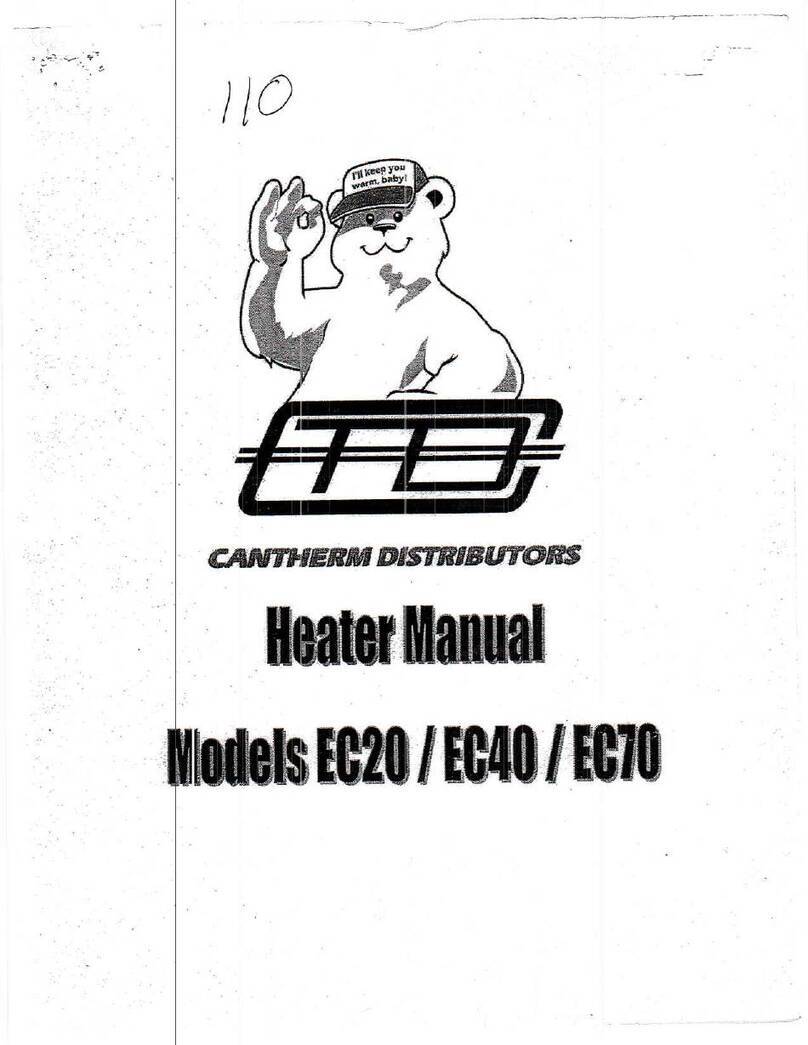
EN
L-L 265.00-BM 7 / 24
IMPORTANT
Before using the space heater, carefully read all of the instructions and follow them scrupulously. The manufacturer cannot be
held responsible for damage to persons and/or property caused by improper use of the equipment.
This instruction manual is an integral part of the equipment and must therefore be stored carefully and passed on with the unit in
the event of a change of ownership.
1. DESCRIPTION
Space heaters described in this manual, are designed for use in
medium to large-sized rooms and buildings where a fixed or mobile
heating system is required.
The air required for combustion is sucked directly by the burner (6)
installed on the heater, and can be supplied:
• from the outside by using the flexible connection tube (available
as an accessory), which avoids consuming oxygen in the room to
be heated, or
• from inside the room to be heated. In this case, the room must be
well ventilated to guarantee sufficient exchange of air.
The flow of hot air is moved by the high-efficiency fan (4): air is
heated by the thermal energy generated during la combustion and
heat from the smoke is transmitted to the fresh air through the
metal walls of the sealed combustion chamber and the heat
exchanger. After the combustion products are cooled, they are
conveyed to a discharge duct and eliminated through a chimney or
flue large enough to guarantee their removal.
The space heaters can work with burners having ON-OFF work
modes and fuelled by natural gas or propane.
Warning
Only burners approved by the manufacturer and listed in
the “TECHNICAL SPECIFICATION TABLE” can be used.
The heater’s certification and warranty will lapse if the
burner is replaced with a non-original model, even if it has
similar specifications.
All of the space heaters are fit with an electronic device that
controls the flame and with:
• safety devices (safety thermostat with manual reset, flame
control, air pressure switch) that trip in case of serious
malfunctions and cause a safety stop. In this case the heater
stops, button (d) lights with a steady red light (Stop Light) and the
heater can resume operation only after the cause of the stop has
been identified and eliminated;
• control devices (temperature controller to control temperature of
air outflow, complete with hour counter, fan thermostat, burner
thermostat, voltage control) that trip in case of minor operating
faults or supply faults, causing temporary stop of the space
heater. In this case, the heater will restart automatically when the
required condition is restored.
The section “TROUBLESHOOTING” describes all possible operating
faults and their possible remedies.
2. CONDITIONS OF SUPPLY
The heater is delivered with parts to be assembled and set as
described in chapter 4.
• Heater body
• Burner
• Air distribution connector
• Any required accessories (flue pipes, air distribution pipes, etc.)
Warning
Prior to installation, burner adjustment and ignition, the
space heater should be assembled in full.
All assembly operations should only be performed by
professionally qualified personnel only.
The following are also supplied:
• use and maintenance manuals for
• space heater
• burner
• manuals with drawings and spare part lists:
• space heater
• burner
Warning
All documents provided constitute an integral part of the
unit.
The documents should therefore be looked after with care
and supplied with the unit in the event of a change in
ownership.
Parts are to be transported and moved using either a manual or
automatic forklift truck with sufficient load capacity.
Warning
Never try to lift the heater manually. Doing so could cause
serious physical injury.
3. GENERAL ADVICE
The space heater must be installed, adjusted, and used in
conformity to national and local laws and regulations for its
operation.
General guidelines:
• Follow the instructions in this booklet very carefully;
• The heater is not installed in an area where there is a high risk of
fire or explosions;
• Minimum clearances from combustible material must be:
1 m (3 feet) from side and rear (air inlet) of heater
1 m(3 feet) on top of heater
3 m (10 feet) on air outlet of heater.
• Keep inflammable material at a safe distance from the heater
(minimum 3 metres);
• Check that there is no overheating of walls, ceilings or floors made
of inflammable materials,
• All precautions have been taken to prevent fires;
• The room being heated must be sufficiently ventilated so that the
heater has enough air to function properly;
• The heater must be near a chimney or chimney flue and an
electrical panel conforming to declared specifications;
• Check the heater before switching it on and at regular intervals
during its use;
• After use, make sure the disconnecting switch is off.
When using any type of space heater it is obligatory:
• not to exceed the maximum heat output level of the furnace
(“TECHNICAL SPECIFICATION TABLE”);
• make sure that the air flow is not below the rated level; check that
there are no obstacles or obstructions to the air suction and/or
delivery ducts, such as sheets or covers on the equipment, walls
or large objects near the heater.





























